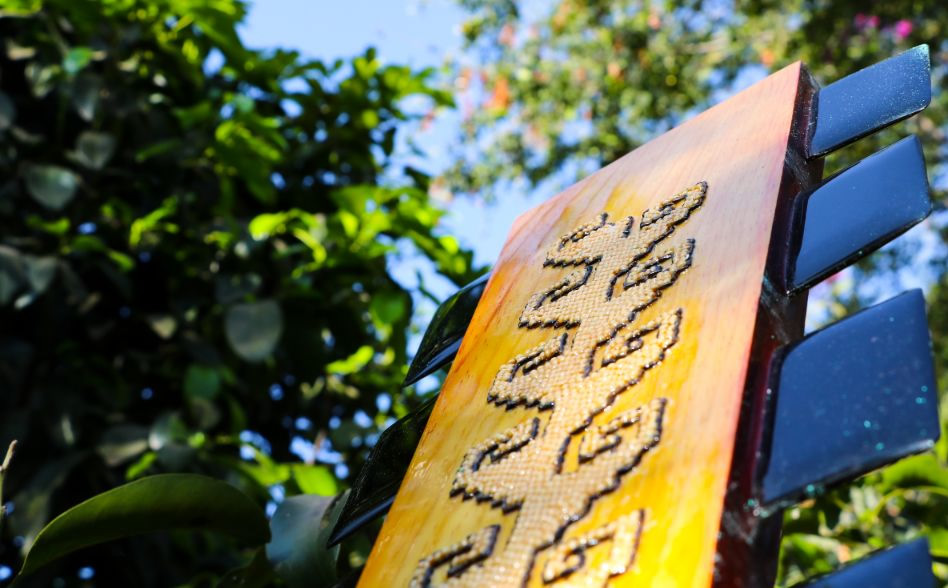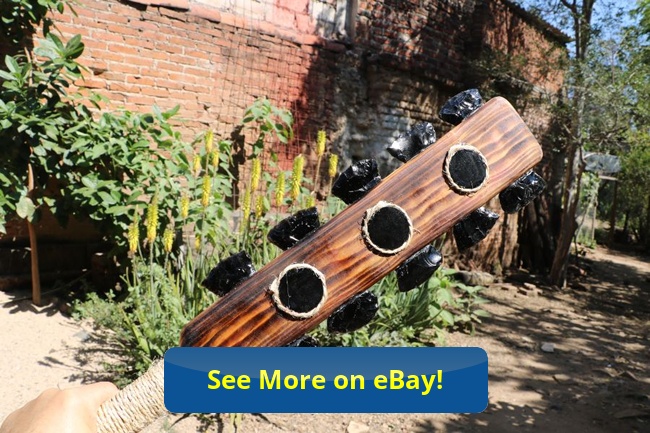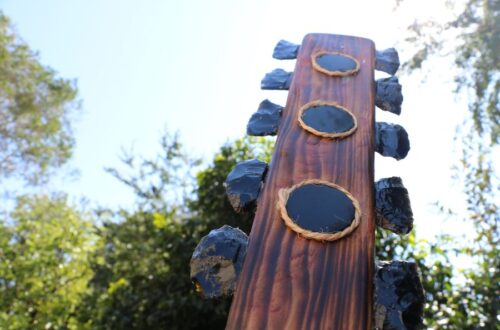Macahuitls for Sale: Where to Buy!
The macuahuitl represents the pinnacle of Mesoamerican weapon craftsmanship. This obsidian sword struck fear into Spanish conquistadors and remains one of history’s most ingenious weapons. Finding authentic reproductions requires understanding both the weapon’s sacred origins and today’s marketplace realities.
The name derives from the Nahuatl language, meaning “hand-wood.” These wooden swords embedded with razor-sharp obsidian blades could decapitate a horse with a single swing. Modern collectors seek pieces that honor this extraordinary Aztec weapon’s legacy.
Sacred Origins of the Obsidian Sword
The macuahuitl emerged from the volcanic landscapes of central Mexico over a millennium ago. Use of the macuahuitl as a weapon is attested from the first millennium CE, although specimens can be found in art dating to at least pre-classic times. By the time of the Spanish conquest the macuahuitl was widely distributed in Mesoamerica.
Multiple civilizations wielded these fearsome weapons. The weapon was used by different civilisations including the Aztec (Mexicas), Olmec, Maya, Mixtec, Toltec, and Tarascans. Each culture adapted the basic design to their specific combat needs and spiritual beliefs.
The Aztec Empire perfected these obsidian weapons during their military expansion. Elite warriors carried elaborately decorated macuahuitls as symbols of their status. Advancement into the elite cuāuhocēlōtl warrior societies of the Aztec, for example, required taking 20 live captives from the battlefield.
Why Obsidian Made These Weapons Legendary
Obsidian represents nature’s sharpest cutting material. Its sides are embedded with prismatic blades traditionally made from obsidian, which is capable of producing an edge sharper than high quality steel razor blades. This volcanic glass surpassed any metal blade technology available to Spanish forces.
Several obsidian mines were close to the Aztec civilizations in the Valley of Mexico as well as in the mountains north of the valley. Among these were the Sierra de las Navajas (Razor Mountains), named after their obsidian deposits. This abundant natural resource allowed Aztec craftsmen to create weapons of unprecedented sharpness.
Spanish chronicles documented the weapon’s devastating effectiveness. Conquistador accounts describe macuahuitls slicing through armor and severing limbs with single blows. According to a comrade of the most famous of the conquistadors, Hernán Cortés, the macuahuitl was capable of delivering horrific damage to foes. He described how the natives were able to slay Spanish horses with a single blow.
However, obsidian’s exceptional sharpness came with limitations. Despite being sharper, prismatic obsidian is also considerably more brittle than steel; obsidian blades of the type used on the macuahuitl tended to shatter on impact with other obsidian blades, steel swords or plate armour.
Authentic Construction Methods and Designs
Historical accounts provide detailed construction specifications for accurate reproductions. According to conquistador Bernal Díaz del Castillo, the macuahuitl was 0.91 to 1.22 m long, and 75 mm wide, with a groove along either edge, into which sharp-edged pieces of flint or obsidian were inserted and firmly fixed with an adhesive.
According to the research of historian Marco Cervera Obregón, the sharp pieces of obsidian, each about 3 cm long, were attached to the flat paddle with a natural adhesive, bitumen. This natural tar provided sufficient bonding strength to secure blades during intense combat.
Blade arrangement varied according to intended use. The rows of obsidian blades were sometimes discontinuous, leaving gaps along the side, while at other times the rows were set close together and formed a single edge. These design variations reflected different combat strategies and cultural preferences.
Multiple sizes accommodated different fighting styles. An archaeologist named Marco Cervera Obregón has studied these weapons. He believes there were two main types: The macuahuitl: This was about 70 to 80 centimeters (27 to 31 inches) long. It had six to eight obsidian blades on each side. The mācuāhuitzōctli: This was a smaller club, about 50 centimeters (20 inches) long. It had only four obsidian blades.
Cultural Significance in Aztec Society
The macuahuitl transcended mere weaponry in Aztec culture. These obsidian swords connected warriors to divine forces and ancestral traditions. Elite warriors earned the right to carry decorated versions through demonstrated battlefield prowess and spiritual dedication.
Human sacrifice formed a central component of Aztec religious practices. The macuahuitl thus shows several features designed to make it a useful tool for capturing prisoners: fitting spaced instead of contiguous blades, as seen in many codex illustrations, would intentionally limit the wound depth from a single blow, and the heavy wooden construction allows weakened opponents to be easily clubbed unconscious with the flat side of the weapon.
The Aztecs were known for taking prisoners alive to be used as human sacrifices to appease their gods at their temples. Terrifying rituals were performed where priests would literally cut out the still-beating hearts of their offerings, blood would literally be pouring down the steps of the temple.
The weapon connected to specific deities within the Aztec pantheon. Military gods blessed warriors who wielded these sacred implements. Ceremonial versions featured intricate carvings and precious metal inlays reflecting their spiritual importance.
Where to Buy a Macuahuitl Online Safely
Buying online provides access to the widest selection of macuahuitl reproductions. However, purchasing such specialized historical weapons requires careful consideration of seller reputation and buyer protections. Established marketplaces offer the safest environment for these transactions.
eBay stands as the most reliable platform for buying a macuahuitl online. The site’s comprehensive buyer protection policies shield purchasers from fraudulent sellers and misrepresented items. eBay’s dispute resolution system protects buyers when items don’t match descriptions or fail to arrive as promised.
Several factors make eBay superior for macuahuitl purchases. PayPal integration provides additional payment security and fraud protection. Seller feedback systems offer transparency about vendor reliability and customer satisfaction. The platform’s global reach connects buyers with artisans worldwide who create quality reproductions.
Specialty weapon retailers also offer macuahuitls through dedicated websites. These vendors often provide more detailed historical information and higher-quality reproductions. However, they typically lack the buyer protection systems found on major marketplaces like eBay.
Always verify seller credentials before purchasing. Established sellers with extensive positive feedback provide greater security than new accounts with limited transaction history. Read product descriptions carefully to understand construction materials and accuracy levels.
Evaluating Quality and Authenticity
Quality macuahuitl reproductions should reflect historical construction techniques and materials. The wooden base must be carved from appropriate hardwood species like oak. Modern makers sometimes substitute other hardwoods for availability reasons while maintaining historical accuracy.
Obsidian blade placement follows specific patterns documented in Spanish codices. Authentic reproductions use genuine obsidian rather than glass substitutes. Hand-knapped obsidian blades demonstrate superior craftsmanship compared to machine-cut alternatives.
Examine blade attachment methods for historical accuracy. Traditional reproductions use natural adhesives like pine resin or bitumen when possible. Modern synthetic adhesives may be substituted for durability while maintaining visual authenticity.
Weight and balance provide important authenticity indicators. It takes more time to lift and swing a club than it does to thrust with a sword. More space is needed as well, so warriors advanced in loose formations and fought in single combat. Proper weight distribution allows realistic handling characteristics.
Mayan Weapons and Regional Variations
The macuahuitl wasn’t exclusively Aztec technology. A Mayan carving at Chichen Itza shows a warrior holding a macuahuitl, depicted as a club having separate blades sticking out from each side. These earlier examples influenced later Aztec designs and military tactics.
Mayan weapons included similar obsidian-edged clubs adapted to jungle warfare conditions. Regional variations reflected local materials and combat preferences. Mountain peoples might use different wood species while coastal populations incorporated marine-based adhesives.
Understanding these regional differences helps collectors appreciate the weapon’s broader Mesoamerican context. Authentic reproductions should specify which cultural tradition they represent. Mayan versions often featured different proportions and blade arrangements compared to Aztec examples.
Pricing Considerations for Collectors
Macuahuitl for sale prices vary dramatically based on construction quality and historical accuracy. Basic decorative replicas start around $50-100 for simple wooden versions without genuine obsidian. Mid-range reproductions featuring real obsidian blades typically cost $200-500.
Premium authentic reproductions with hand-knapped obsidian and traditional construction methods command $500-1000 or more. Museum-quality pieces incorporating historical techniques and materials justify higher costs for serious collectors.
Shipping costs significantly impact total purchase prices. Large, heavy weapons like macuahuitls incur substantial shipping fees. International shipping may face customs restrictions or additional duties. Factor these costs when comparing options from different sellers.
Consider long-term value when evaluating price points. Quality reproductions appreciate over time while inferior pieces lose value. Authentic construction methods and genuine materials provide better investment potential for collectors.
Legal Considerations and Shipping Restrictions
Weapon regulations affect macuahuitl sales and shipping policies. While reproductions typically aren’t classified as weapons under most jurisdictions, some locations impose restrictions. State and local laws may impose additional requirements for possession or display.
Domestic shipping within the United States generally faces fewer restrictions. International buyers encounter more complex challenges. Customs authorities might classify obsidian-edged weapons as prohibited items requiring special permits.
Some sellers refuse international shipments to avoid regulatory complications. Research local regulations before purchasing to avoid legal issues. Contact sellers directly about shipping restrictions to your location.
Educational and display purposes typically receive more favorable treatment than functional weapon sales. Specify intended use when communicating with sellers or customs officials.
Caring for Your Sacred Weapon
Proper care ensures your macuahuitl remains in excellent condition for years. Obsidian blades are extremely fragile and chip easily with minimal impact. Display cases protect these weapons while allowing appreciation of their craftsmanship.
Humidity control prevents wooden components from warping or cracking. Direct sunlight damages both wood and obsidian over time. Temperature fluctuations cause expansion and contraction that may loosen blade attachments.
Regular inspection helps identify potential problems before they worsen. Loose obsidian blades should be re-secured immediately to prevent loss or damage. Professional conservation may be necessary for valuable pieces showing deterioration.
Handle reproductions minimally to prevent accidental damage. Use padded gloves when moving pieces to avoid skin oils and accidental drops. Store weapons horizontally to prevent stress on blade attachments.
Supporting Indigenous Artisans
Purchasing from Native American or Mexican artisans supports cultural preservation efforts. These craftspeople often possess traditional knowledge passed down through generations. Their work helps maintain connections to ancestral practices and beliefs.
Cultural appropriation concerns arise when non-Indigenous sellers commercialize sacred symbols. Research sellers’ backgrounds and cultural connections before purchasing. Supporting Indigenous-owned businesses honors the weapon’s cultural significance.
Educational value increases when purchases include accurate historical information. Reputable sellers provide context about the macuahuitl’s role in Aztec society and warfare. This knowledge enhances appreciation beyond mere ownership.
Look for artisans who collaborate with Indigenous communities or museums. These partnerships ensure cultural accuracy and appropriate representation. Avoid sellers who misrepresent cultural significance or make exaggerated claims.
Building a Meaningful Collection
Starting a macuahuitl collection requires thoughtful planning and research. Begin with a single quality piece rather than multiple inferior reproductions. Quality over quantity ensures each acquisition adds meaningful value to your collection.
Documentation enhances collection value and educational potential. Record each piece’s specifications, maker information, and acquisition details. Photography helps track condition changes over time and provides insurance documentation.
Networking with other collectors provides valuable insights and trading opportunities. Online forums and social media groups connect enthusiasts worldwide. These communities share knowledge about reputable sellers and authentic construction techniques.
Consider specializing in specific regional variations or time periods. Focused collections develop greater expertise and market value. Breadth versus depth represents a fundamental collecting philosophy decision.
Your Journey into Aztec Warrior Heritage
The macuahuitl represents more than a weapon—it embodies the ingenuity and spiritual beliefs of an entire civilization. These obsidian swords connected Aztec warriors to their gods while providing practical battlefield advantages. Modern reproductions allow us to appreciate this remarkable achievement.
Buying a macuahuitl online requires balancing authenticity, quality, and budget considerations. Established platforms like eBay offer buyer protections while specialty artisans provide superior craftsmanship. Research and patience lead to acquisitions that honor this weapon’s sacred heritage.
Whether displayed in your home or studied for historical insights, a quality macuahuitl connects you to the warrior spirit of ancient Mesoamerica. These obsidian weapons remind us that innovation and spiritual purpose can create tools that transcend their original function to become lasting symbols of human achievement.




